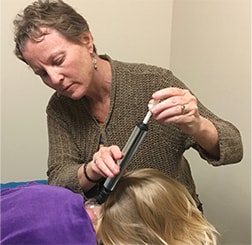Acupuncture is effective for neck pain.

Neck pain can be chronic (long-term) or acute (recent and often intense). The quality of the pain can range from achy to burning to throbbing or even stabbing. It can be a minor annoyance or so extreme as to keep you from working or even you’re your activities of daily living. Causes of chronic neck disorders include: unresolved whiplash, sports traumas, or work injuries; ongoing wear and tear leading to neck arthritis; muscles tightened by holding your head or jaw in certain positions for procedures such as dental work; strains resulting from repetitive motions such as lowering your head to read or text; and neck pain resulting from other illnesses. There are too many to list them all.
Can acupuncture relieve neck pain?
According to a Cochrane Review (including 27 studies with evidence up to August of 2015), it sure can! Acupuncture was proven to provide immediate and sustained pain relief and increased functioning for people suffering from acute and chronic neck disorders. The disorders studied included: whiplash, neck arthritis, chronic myofascial neck pain, radiculopathy - sending radiating aches or tingling down the arm, mechanical neck pain, and non-specific neck pain. Acupuncture was confirmed as a safe modality with minor adverse effects, such as occasional bruising.
Cupping and gwa sha adds to the benefit
The addition of cupping (stationary or sliding cups) as part of your treatment can increase and prolong the benefit of the acupuncture. The suctioning action of the cups draws out tightness and stagnation from muscles and increases blood flow to places that need to heal. Gwa sha, a gentle rubbing/scraping technique, is especially good for tight muscles after athletic training.

Kinesiotaping can also help
Kinesiotaping includes specialized taping techniques that support overworked muscles, reducing inflammation, and relieving tension in a region of the body.
Moxibustion
The herb, moxa (Artemisia vulgaris) can be burned over specific sites in the body. Moxa offers delightful warming and tonification. In our opinion and experience, moxa works much better and longer that ice packs.
Self-care for Neck Disorders
1) Stretch your Neck Nightly – Be sure not to over-strain or irritate the muscles while doing this. With a straight back and relaxed shoulders, look up for 10 seconds. Tilt your head to the right (ear to shoulder – with your shoulder and down) for 10 seconds. Tilt your head to the left for 10 seconds. Then, tuck you chin as far into your chest as you can and hold for 5 seconds. Repeat 2 to 3 more times. Note: Do not circle your head all the way around. This motion has been shown to increase risk of injury.
2) Self-Massage - Massage the back of your neck in gentle circular motions.
3) Relax to reduce muscle tension. (Yoga, tai chi, massage, warm baths, and walks in nature all can help.
Other Modalities Can Also Help
Chiropractic adjustments can improve skeletal mechanics and ease pain. Massage can reduce stress, improve circulation, reduce swelling, and ease tension. Both chiropractic and massage work very well in conjunction with acupuncture.
References
Eliopoulos, E. (2010). Invitation to Holistic Health. Sudbury, MA: Jones & Bartlett Publishers.
Palkhivala, A. Acupuncture May Be Best To Ease Neck Pain. WebMD, 2001.
Trinh K. and Graham N, et al. Acupuncture for Neck Disorders. Cochrane. May, 2016.
www.spine-health.com/treatment/alternative-care/acupuncture-ancient-treatment-a-current-problem





